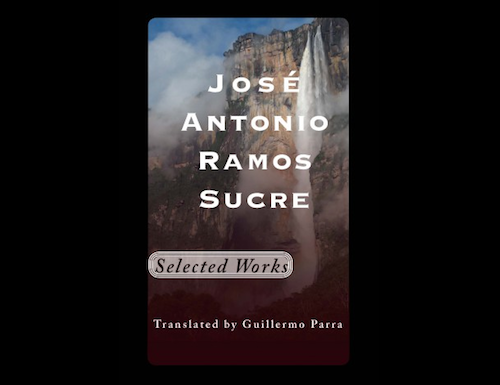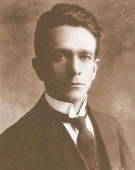José Antonio Ramos Sucre: Three Short Stories
by Sampsonia Way / December 19, 2012 / No comments
In light of the holiday season, Sampsonia Way asked our Fearless Ink. columnists for three reading recommendations. They chose books that have inspired, influenced, or enriched them and we are publishing an excerpt of one of their suggestions. To see all the recommendations made by the columnists, check the Holiday Recommendations factbox below!
Below Sampsonia Way presents three pieces from José Antonio Ramos Sucre, Selected Works, which is now available for the first time in English. This edition released by The University of New Orleans Press is translated by Guillermo Parra. “The Fugitive” was originally published in Timon’s Tower (1925), “The Punishment” was originally published in The Forms of Fire (1929), and “The Foreigner” was originally published in The Enamel Sky (1929)
“The Fugitive”
I was anxiously fleeing, with sore feet, through the hinterlands. The snow flurry was dampening the black ground.
I was hoping to save myself in the forest of birches, incurved by the squall.
I was able to hide in the antrum caused by the uprooting of a tree. I composed the manifested roots so as to defend myself from the brown bear, and scattered the bats with shouts and hand claps.
- José Antonio Ramos Sucre
- José Antonia Ramos Sucre (1890-1930) a direct descendant of one of the founding fathers of Venezuelan Independence, Antonio José de Sucre, was born in Cumaná, Venezuela to an aristocratic family in 1890. He studied law at the Universidad Central de Venezuela in Caracas and received, but never practiced, his law degree. It was during his time at the university that he began writing poems and essays in newspapers and magazines. He dedicated most of his life teaching History, Geography, Latin, and Greek in high school. He served as a translator and interpreter for the Venezuelan Foreign Ministry. In 1929 he moved to Europe and took a position at the Venezuelan Consulate in Geneva.
Sucre self-published all four of his books: Trizas de papel (1921), La Torre de Timón (1925), El cielo de esmalte (1929), and Las formas del fuego (1929).
I was bewildered by the blow I had received on my head. I was suffering hallucinations and nightmares in the hiding place. I understood I would escape them by running further.
I crossed the quagmire covered with long, amplective reeds, and emerged into a second desert. I would abstain from lighting a campfire lest they reach me.
I would lie down in the open air, numbed by the cold. I was glimpsing the messengers of my methodical executioners. They were following on horseback, assisted by black dogs, with eyes of fire and ferocious howls. The riders displayed, for a crest, a squirrel’s tail.
I could make out, when I reached the border, the light of asylum, and I ran to crouch at the feet of my god.
His seated image listens with lowered eyes and smiles gently.
“The Punishment”
The visionary would teach me numeration using a tree of incalculable leaves. He proceeded to initiate me in the figures and volumes pointing out the example of the crystal and the proportion held between the parts of a flower. He would discover
an atom of the insinuating light in the dark body.
The visionary would disappear in a skiff of superficial capacity when dusk fell. It created the illusion of foundering at an ambiguous distance, amidst a tumult of waves. I would watch the relics of his garb and his cypress crown floating.
He would return the next day hidden from me, wearing the same solemn gown of a Hebrew priest, according to the ritual of Moses.
At the time he was commenting the passage on a parchment scroll, written without vowels. The cover showed the image of the lycaeon, the African wolf. He would conclude by citing the name of the vengeful prophets and loosening onto the morning’s face a
grandiose hymn that would exhaust the torrent of his voice.
I stopped seeing him when he began to speak recklessly, across free space, with a magnetic star.
The rotunda, where he had taken shelter, fell to the ground suddenly, surrounded by splendid flames.

- Holiday Recommendations
- –José Antonio Ramos Sucre, Selected Works translated by Guillermo Parra
- –La tarea del Testigo by Rubi Guerra
- –Chulapo Mambo by Juan Carlos Mendez Guidez
- Israel Centeno was born in 1958 in Caracas, Venezuela, and currently lives in Pittsburgh as a Writer-in-Residence with City of Asylum/Pittsburgh. He writes both novels and short stories, and also works as an editor and professor of literature. He has published nine books in Venezuela and three in Spain.
“The Foreigner”
He had resolved to hide for suffering. He was at leisure in a sepulchral house, asylum of the decadent moss and the senile mushroom. A useless lamp was signifying idleness.
He had renounced the scruples of civilization and considered it an image of softness. He was resting audaciously in the open air, amid prehensile grass.
He was insinuating the image of a primary being, an attempt or delirium of life in a torrential season. His muddy hair and beard seemed altered with the sediment of a lacustrine refuge.
He would dress in flowers and leaves to celebrate the vicissitudes of the sky, culminating ephemeris in the rustic calendar.
He would entertain himself with the thought of returning to the heart of the Earth and losing himself in its darkness. He would prepare for nakedness in the indistinct pit by throwing himself into nature’s fates, receiving in his person the elusive summer rain. He ceased to exist on a day in November, month of the silhouettes.
Excerpt from José Antonio Ramos Sucre, Selected Works. Translated by Guillermo Parra. Copyright 2012 by University of New Orleans Press. Used by permission of University of New Orleans Press. All rights reserved.






